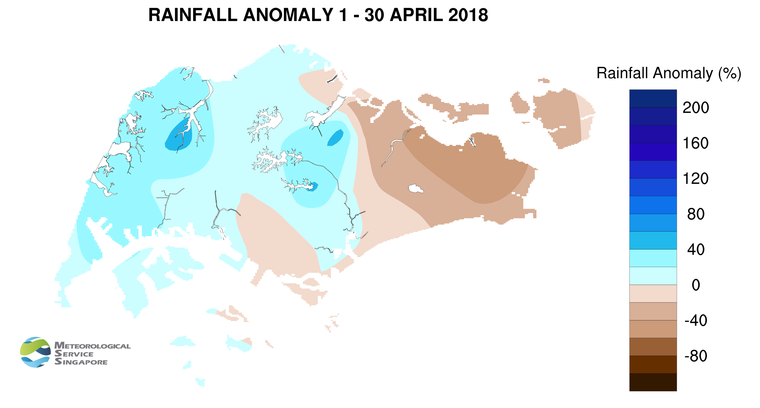Inter-monsoon conditions to persist with prevailing winds that are light and variable in direction. Expect mostly afternoon thundery showers with high lightning activities during the period.
Singapore, 2 May 2018 – The prevailing inter-monsoon conditions are expected to persist over Singapore and the surrounding region in May 2018. The low level winds during the first fortnight of May 2018 are forecast to be light and variable in direction.
2 During the inter-monsoon period, weak prevailing winds coupled with strong solar heating of land areas make it conducive for the development of thunderstorm clouds which could grow to heights more than 10-12 km. Climatologically, the moderate to heavy thundery showers during the inter-monsoon months tend to fall more in the afternoon than at other times of the day. In addition, lightning activities tend to be more intense during this period. May has the second highest number of lightning occurrences after November.
3 The first fortnight of May 2018 is expected to be wet with most of the thundery showers falling in the first week of May 2018. During the fortnight, short-duration moderate to heavy thundery showers are expected mostly in the afternoon on six to eight days. On a few of these days, the thundery showers could start earlier in the late morning and extend into the afternoon. On one or two days in the fortnight, the prevailing winds could shift to blow from the southwest, and could bring widespread thundery showers with gusty winds to the island in the morning. The rainfall in the first fortnight of May 2018 is expected to be near normal.
4 May is climatologically one of the warmest months of the year. During the first fortnight of May 2018, the daily temperature is expected to range between 25°C and 33°C. A few warm days are expected during this period where the daily maximum temperature could reach a high of around 35°C on a few afternoons.
5 For updates of the daily weather forecast, please visit the MSS website (https://www.weather.gov.sg), NEA website (www.nea.gov.sg), or download the myENV app, MSS’ Weather@SG app.
REVIEW (1 – 30 April 2018)
6 Inter-monsoon conditions onset in early April 2018 and persisted for the rest of the month. The prevailing winds in April 2018 were predominately light and variable in direction.
7 In April 2018, most of the thundery showers experienced in Singapore fell in the afternoon due to strong daytime heating of land areas. On a few of these days, the thundery showers extended into the evening. The second half of April 2018 was wetter than the first half of the month, and the thundery showers were also more intense. The three highest daily total rainfall recorded in April 2018 were 83.0mm, 109.8mm and 138.0mm on 23 April, 20 April and 7 April 2018 respectively.
8 In April 2018, the daily maximum temperature ranged between 31.5°C and 35°C, and the daily minimum temperature ranged between 22.0°C to 25.5°C. The highest daily maximum temperature of 35°C was recorded at Pulau Ubin and Changi on 25 April 2018. This ties with the highest daily maximum temperature recorded in 2016 at the climate station in the last ten years. The highest daily maximum temperature recorded at any station across the island in the last ten years was 36.6°C at Pulau Ubin in 2016.
9 About two-thirds of Singapore received above-normal rainfall in April 2018. The lowest rainfall of 61.2 mm (59% below average) was recorded at Changi. Rainfall was highest around Choa Chu Kang where 408.1mm (58% above average) was recorded.
CLIMATE STATION STATISTICS FOR MAY (Climatological reference period: 1981 – 2010)
| Mean daily maximum temperature | 32.2 °C |
| Mean daily minimum temperature | 25.4 °C |
| Mean monthly temperature | 28.3 °C |
| Mean rainfall for the month | 171.2 mm |
| Mean number of rain days | 14 |
| Highest monthly mean daily maximum temperature | 33.6 °C (1997) |
| Lowest monthly mean daily minimum temperature | 24.5 °C (1981,1982,1984,1989) |
| Highest monthly rainfall | 370.8 mm (1998) |
| Lowest monthly rainfall | 41.6 mm (1997) |

